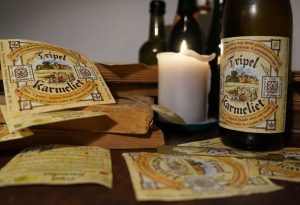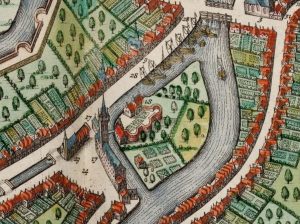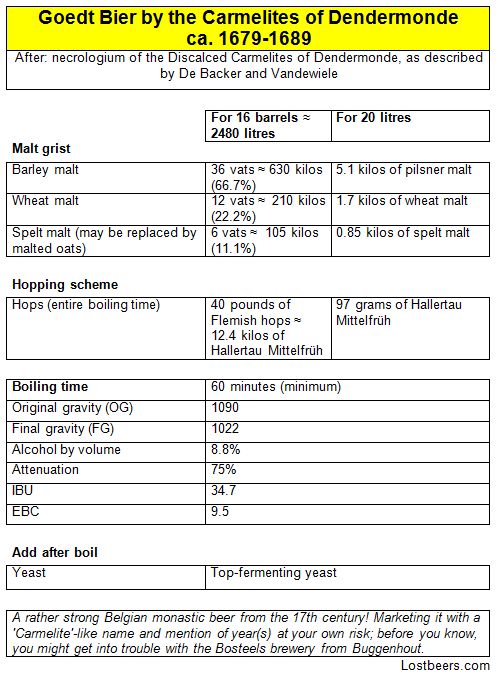The original 17th century Tripel Karmeliet recipe
 Tripel Karmeliet is one of Belgium’s most famous beers. It has received multiple international awards and rightly is considered a modern classic. And according to the label it is brewed ‘according to a 17th century recipe from the Carmelite monastery in Dendermonde’. Which of course made me wonder: what recipe? Or: why real Carmelites are not allowed to brew this anymore.
Tripel Karmeliet is one of Belgium’s most famous beers. It has received multiple international awards and rightly is considered a modern classic. And according to the label it is brewed ‘according to a 17th century recipe from the Carmelite monastery in Dendermonde’. Which of course made me wonder: what recipe? Or: why real Carmelites are not allowed to brew this anymore.
Lately I’ve started to occupy myself a bit more with Belgium, where beer history is concerned. Firstly of course because Belgian beer is incredibly good, but secondly because the existing literature does not answer the questions I’d like to see answered. Where have all those beers and breweries gone that are still advertised by scores of enamel signs in every Belgian pub? Why has the beer type Spéciale Belge (Palm, De Koninck) been invented in 1905 to counter the rise of pils, while the apparent first Belgian pils, Cristal Alken, dates only from 1928? Surely it wasn’t just because of imported beer?
I’d really like to clear things up when it comes to Belgian beer. Not to ruin the fairy tale, after all life is much more fun when La Chouffe really is brewed by leprechauns, but just to fit all loose facts and trivia into a framework that makes sense.

Father and son Bosteels on the Belgian tv show Tournée Générale (2011), explaining how they came up with Tripel Karmeliet.
So, Tripel Karmeliet. It was introduced in 1996 by the Bosteels brewery from the East-Flemish town of Buggenhout. A 8% ABV triple made from three grains: barley, wheat and oats. It became especially known after winning a ‘World’s Best Pale Ale’ award at the World Beer Awards in 2008, when sales went up so quickly that for a while there was a worldwide Karmeliet shortage.[1]
In an episode of the Flemish tv series Tournée Générale, Antoine Bosteels spoke quite openly about the birth of their Tripel Karmeliet. In fact, the idea of a three grains beer came first. ‘That was actually our concept, when we came up with the idea of a multi-grain beer in 1993, just like multi-grain breads. We researched it for three years, but hadn’t come up with a name. By chance, I found a book about breweries in the region and my eye was drawn to a 1679 recipe from the Carmelite monastery in Dendermonde. I looked and it contained the same grains that we had used in our test beer and for 90% it was the same formula.’[2]

The 17th century Carmelite monastery in Dendermonde was located on an island in the Dender river. Source: Wikipedia
All in all I became more and more curious for this original recipe. The Carmelites are a Roman Catholic monastic order founded in the Middle Ages, and they still have monasteries in Belgium and the Netherlands. In Dendermonde, a fortified town on the Schelde river, the Carmelites had been present from the year 1655 onwards.[3] The monks also had beer brewed, just like in many other monasteries, although these monastic beers did not even remotely enjoy the fame today’s Belgium abbey beers have, and their production volumes probably weren’t so great either.
In 1796 the Dendermonde Carmelites were thrown out of their monastery by the French, just like everywhere else in what is now Belgium. The abbey became a courthouse, which went up in flames during the First World War, when the Germans set the entire city on fire. No trace of the Carmelites remains today in the streets of Dendermonde.
And yet, a beer recipe has survived. In Gent, at the Carmelite archive, there is a manuscript bound in parchment, containing a list of deceased monks of the Dendermonde monastery. At the end of the manuscript however, there is an account of the Carmelites’ debts and obligations. And among these lists, there is this recipe:[4]
Instruction to brew 16 barrels of good beer
12 vats of wheat at 24 stuivers per vat, that is 14.8 guilders
36 vats of barley at 20 stuivers per vat, that is 36 guilders
6 vats of spelt or ‘vorte avere’ [rotten oats?] at 18 stuivers, that is 5.8 guilders
40 pounds of hops at 3 stuivers a pound, that is 7.10 guilders
5 ‘waeghen’ of coal at 30 stuivers a ‘wage’, that is 7.10 guilders
50 pieces of wood at 6 guilders per 100, that is 3 guilders
for wear and tear and brewer’s work 8 guilders
80.6 guilders
See below for my interpretation of this recipe. To my surprise, the result is a beer that is slightly heavier than the Bosteels version! It does contain three grains, but they are wheat, barley, and spelt. However, spelt apparently could be replaced by ‘vorte avere’, which the authors of the 1981 article about this recipe interpret as ‘rotten oats’. That sounds rather odd, but maybe they made an error during transcription or they just misinterpreted. [Edit: the original text probably said ‘corte avere’, ‘short oats’.] In any case, the fact that Bosteels replaced spelt with oats (or rather, they already had a recipe with oats in it and they simply associated it to the historical Carmelite recipe) is not historically unjustifiable.
Also it is interesting to see that they used coal and wood – probably the coal was used for roasting the malt, and the wood to heat and boil the wort. It seems that the monks didn’t brew themselves, because they paid a brewer for his work. In any case, it looks like a typical beer for its time, because other monastical beers from the 17th century, like the 1627 Jesuit beer from Brussels, were strong three grain beers as well.[5]
A last issue is the date attached to the beer, because the year is not so precise as Bosteels wants us to believe. The historical recipe speaks of guilders and stuivers. Guilders were gold coins, and one guilder was worth 20 stuivers. Or at least this was the case from 1679 onwards, because before that year, a guilder was worth no less than 28 stuivers. (It makes you wonder how such a change was put into effect; just imagine the chaos if they would suddenly decide to divide the euro or dollar into 120 cents instead of 100…) In any case, the guilder mentioned in the recipe consists of 20 stuivers, and so it dates from 1679 or later. And also it dates from before 1689, because in that year a different monk with a different handwriting started to write down the records. Therefore, it’s a recipe dating from the years between 1679 and 1689, and it’s no more precise than that!
By the way, the Carmelites in Dendermonde may have had a good reason to write down their recipe for ‘Good beer’ in that period: in 1676 the city had decreed that all citizens had to demolish their private breweries, to facilitate collecting excise taxes. Possibly, the Carmelites were afraid they had to do likewise or maybe they had already been forced to so: in any case it may have been a good idea for them to write down a well-proven recipe.[6]
The actual dating of ‘ca. 1679-1689’ simply became ‘1679’ on Bosteel’s Tripel Karmeliet labels, and the indication that it is ‘still’ brewed according to a 17th century Carmelite recipe can be taken with a pinch of salt, for a beer that was only created in 1996. That said, it still is a wonderful beer that rightly enjoys a good reputation, and also it is a clear example of the always innovative Belgian beer culture.

The ‘Good Beer’ of the Carmelites in Bruges, after the same historical recipe, was not allowed to be called ‘Karmeliet’.
Therefore, it does have a sour aftertaste that when the real Carmelites, namely those of Bruges, wanted to brew and sell a beer that was also based on this old recipe, they immediately got into trouble with Bosteels. Even when it came to using the name ‘Karmeliet’ (the Dutch word for ‘Carmelite’) the monks had to be careful: they wanted to simply call it ‘Goedt Bier’ (‘Good Beer’). In the end, they made a settlement with Bosteels that was not made public. As a result, the Goedt bier that was scheduled to be released at Easter 2016, has still not hit the stores.[7] All in all this was a particularly unfair action by Bosteels, that for over twenty years has been using the order’s name for their own profit at zero cost (after all, it is not a registered abbey beer)… Or are the Carmelites receiving royalties now?
Interpreting the recipe
The calculation De Backer and Vandewiele made in their 1981 article doesn’t seem to make much sense. They equate a vat to an almud, and they equate that to a hectolitre, which would result in an impossibly heavy malt grist. Therefore, I equate a vat (as a measure for grains) to about 17.5 litres; in the neighbouring Land of Aalst a vat (as a measure for grains) was equal to 17.8 litres and in Northern Brabant a vat was also usually between 15 and 20 litres.[8]
For a barrel I take 155 litres, which was the usual content in the northern Netherlands, and as yet I have not found a reason to suppose something else for Belgium. I have derived the densities of the grains from Leen Alberts’ work, I equate the density of spelt to that of wheat, and I estimate the bitterness of Flemish hop at 2.5% alpha acid.[9]
[1] Het Nieuwsblad 13-2-2009. Note that the World Beer Awards are just one of many international beer competitions, that Tripel Karmeliet did end as one of the seven highest-rated beers but did not become ‘World’s Best Beer’ , and that brewers have to pay do be part of the competition, which means that only a limited number of beers actually participate; cf. http://www.worldbeerawards.com/2008 op web.archive.org.
[2] Broadcast Tournée Générale VRT één 9-2-2011 (season 2 episode 4); the book referred to is probably Aimé Stroobants, Tussen pot en pint. Herinneringen aan de Dendermondse brouwers, Dendermonde 1990, p. 8.
[3] Christian De Backer and Leo J. Vandewiele, ‘Een recept van Dendermonds Karmelietenbier uit ca. 1679’, in: Kring voor de geschiedenis van de pharmacie in Benelux nr. 61 (februari 1981), p.2-8; cf. Guido van de Velde, ‘Tripel Karmeliet’, in: Ter Palen, jaargang 21 (1996), nr. 1, p. 15-18.
[4] De Backer and Vandewiele, ‘Een recept’, p. 4.
[5] Cf. Erik Aerts and Eddy Put, ‘Jezuïetenbier. Bierhistorische beschouwingen bij een brouwhandleiding uit 1627’, in: Volkskunde jaargang 93 nr. 1 (januari-maart 1992), p. 94-133.
[6] De Backer and Vandewiele, ‘Een recept’, p. 5; Stroobants, Tussen pot en pint, p. 13-14.
[7] Het Laatste Nieuws 26-2-2016, 26-3-2016; Het Nieuwsblad 10-3-2016, 26-3-2016. They already have a website: http://goedtbier.be/
[8] https://familiegeschiedenis.be/toolsenhulp/oude-maten-en-gewichten; http://www.meertens.knaw.nl/mgw/maat/128.
[9] Leen Alberts, ‘Bier drinken met maten. Dronkenschap en het alcoholgehalte van Stichtse en Hollandse bieren in de late middeleeuwen’, in: Jaarboek voor de Middeleeuwse geschiedenis vol. 13 (2010), p. 113-166.








Congratulations. Fantastic article!!
My query would be the use of Pilsner malt in the recipe. What colour would have been likely with 17th century kilning? Definitely not that pale! The British were only just developing ‘modern’ kilning techniques for pale malt and as far as I know this knowledge had not been exported.
Is the likely best replacement an amber malt with some aroma malt from Dingemans (diastatic brown malt is not available these days)
Great article!
-Also as far as I understand Biere Speciale Belge was created to counter the popularity of British Pale Ale not Pilsner – which makes much more sense looking at the dates
Hi Jonny, thanks for your input. As for the malt, you’re probably right: malting in those days usually resulted in not very pale malt. That said, there was also the method of ‘wind kilning’: not using any heat at all, but simply spreading out the malt on an attic and have it dried by the wind. It’s hard to say which method the Carmelites used.
As for the Speciale Belge, it probably was concieved to counter imports from both the UK and Germany. In 1905, imports into Belgium accounted for about 1.2% of total consumption, and that number was rising fast. Unfortunately, I don’t have figures of how much from each country. Probably imports came from both the UK and Germany in similar quantities. Exports from Belgium were marginal: 0.04% of total production was exported! (Today, that is about 60%.)
In any case, the point is, I think we both agree that those that say that Speciale belge was concieved to counter the popularity of pilsner, are probably wrong. British exports into Belgium were considerable and German exports probably consisted in a variety of beers (Munich, Vienna), of which pils was only one.
[…] bardzo ciekawy artykuł na temat piwa i jego 17-wiecznej receptury – http://lostbeers.com/the-original-17th-century-tripel-karmeliet-recipe/ […]
I am going to visit my son in New York in December, he is a brewer and I will see what he makes of this recipe, hopefully he may brew a small amount!
Any idea on yeast strain that might have been used? Did it play as an important a rule in flavouring belgian beers in the past as it does now?
Any ideas on wether to use adjuncts or not?